Activity Insights tracks drawing events and displays those events on a palette when the drawing is open in AutoCAD.
From this palette you can see if your drawing is referenced in another drawing, when it was last published, when it was edited and by whom, and more. Drawing events are not saved in the drawing but are written to a specified location. For better collaboration with other designers, all drawing events can be stored in a shared location.
 Download:
Sample files to use with the exercises in the following sections.
Download:
Sample files to use with the exercises in the following sections.
Setup Event Location
The first thing we need to do is define a common location for drawing events. This should be on an internal company network or a cloud-based storage location.
- Start AutoCAD.
- Start a new drawing.
- If the Activity Insights palette is not open, click
.
Find

- Click Location on the Activity Insights palette.
- Browse to and select a location that you share with your collaborators to track drawing events.
In this example, I have an internal network drive mapped to Z: with a Common folder under that which I select for my shared location.

- Click Open.
- Click .
- On the Files tab, click the plus sign (+) to the left of Activity Insights Event Location to expand the node.
- Select the current file path, click Browse, and select the shared location.
- Click OK.
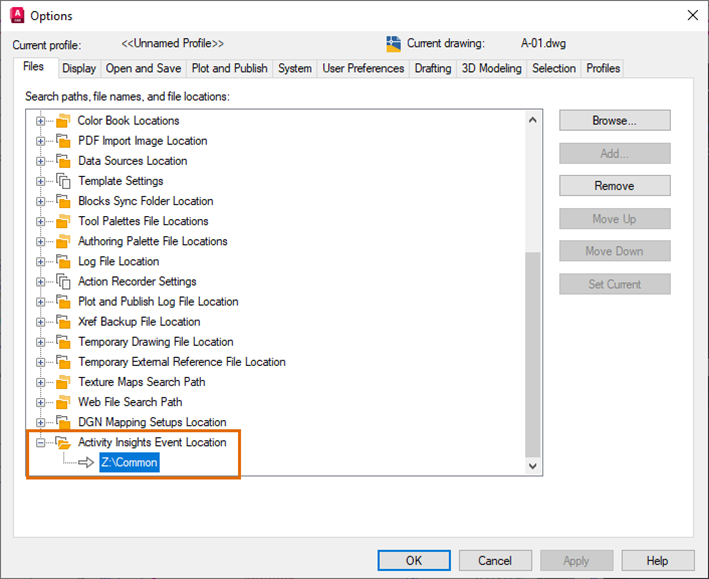
Once all your collaborators set the same location for Activity Insights, all drawing events are written to and read from this location.
Drawing Events
So, what events might you see for your drawings? Let's try a few commands and see what shows up on the Activity Insights palette. You can use your own drawings for these exercises or download the sample drawings.
- Open A-01.dwg or a drawing of your own.
- Click Plot, select a plotter or PDF output device, and click OK.
Find
The published event displays on the Activity Insights palette.
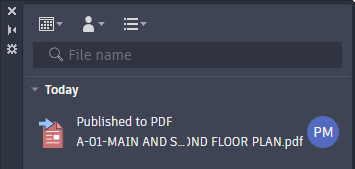 Note: The specific published event depends on the device or output selected.
Note: The specific published event depends on the device or output selected. - Click Purge, select All Items, and click Purge All.
Find
The purged event displays on the palette.

- Draw some geometry, for example some circles and lines.
- Save the drawing.
The saved event displays on the palette.
 Note: Some events don't display on the palette until after you save the drawing.
Note: Some events don't display on the palette until after you save the drawing.Activity Insights doesn't indicate the specific changes but just that the drawing was saved. You can use Drawing Compare and Drawing History to see differences between drawing versions.
Drawing References
Anytime you attach a DWG reference (Xref) to a drawing, this is recorded as an event on the drawing of which the Xref was attached and the source drawing used as the Xref. This can be very helpful when managing your drawing references.
- Start a new drawing.
- Save the drawing as xref_test1.dwg
For the xref drawing, I'll use the Wall Base.dwg from the downloaded sample drawings, or you can use your own.
- Click. Find
- Confirm the Files of Type is set to Drawing (*.dwg), browse to and select
Wall Base.dwg. Click Open.
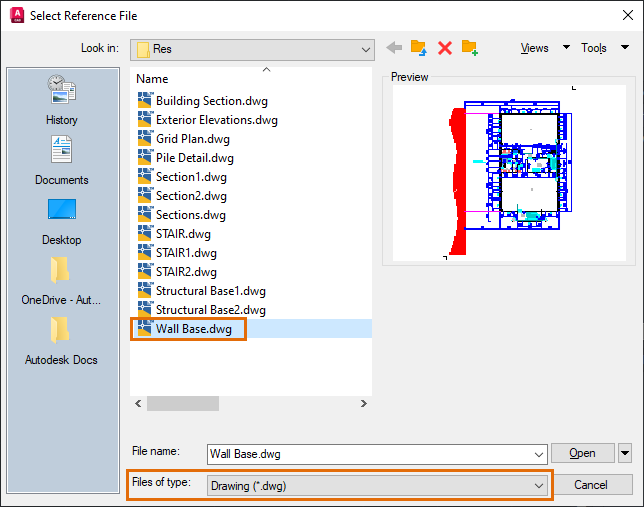
- Use the settings shown in the following image and click OK in the Attach External Reference dialog box.

- Save the drawing.
The Referenced a DWG event is added to the palette.
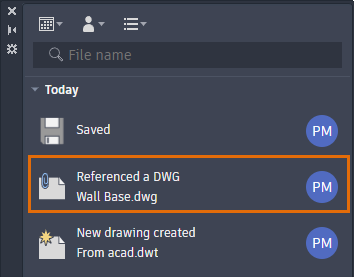
- Hover over the event on the palette to see its details.
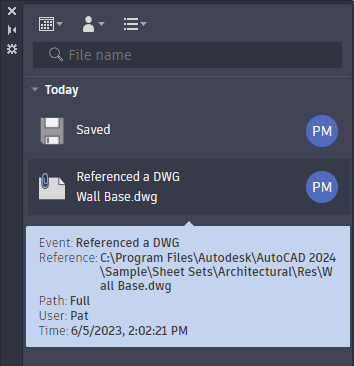
- Click . Find
- On the External Reference palette, select the Wall Base reference or select the drawing file you attached.
- Right-click and select Open.
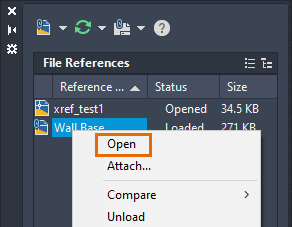
The drawing opens and the Activity insights palette displays the events for the drawing.
- Hover over the Referenced by other DWG event to see its details.
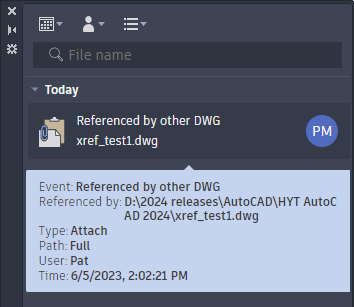
Now we are going to attach the same drawing in a second drawing to see how this really becomes useful.
- Start a new drawing and save it as xref_test2.dwg.
- Attach the same drawing as an Xref as in the earlier steps.
- Switch over to the referenced drawing, in my case
Wall Base.dwg.
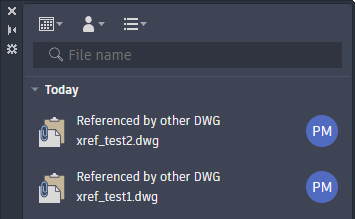
When you open a drawing, an event is shown for each drawing that references the open drawing.
If you want to, go ahead and detach or bind the Wall Base.dwg and see what events are logged for your drawings.
Unknown Events
Activity Insights is currently not supported in the AutoCAD web or mobile apps, AutoCAD for Mac, or in earlier releases of AutoCAD. So, what happens if a collaborator changes the drawing using an application not supported by Activity Insights? Let's give it a try using an earlier release of AutoCAD.
- Close xref_test2.dwg in AutoCAD 2024 if it's still open.
- Open a pre-2024 release of AutoCAD.
- Open xref_test2.dwg.
- Click . Find
- Change the visibility of any layer and save the drawing.
- Close the drawing and return to AutoCAD 2024.
- Open
xref_test2.dwg.
The Activity insights palette displays an Unknown Save event.
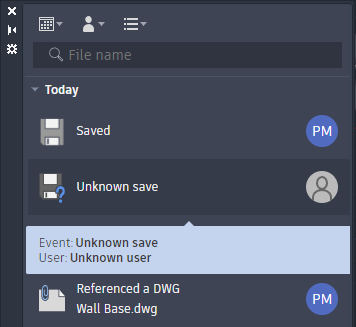
File Explorer Events
In this section, we'll use File Explorer to rename our xref_test2.dwg file and see what type of event is shown on the Activity Insights palette.
- Open File Explorer.
- Navigate to where you saved your xref_test2.dwg.
- Select the file, right-click, and select Rename.
- Enter xref_test2-newname.dwg.
- Return to AutoCAD and open
xref_test2-newname.dwg.
Activity Insights displays a new event, File Renamed.
- Hover over the event to see the details which includes the original file name.
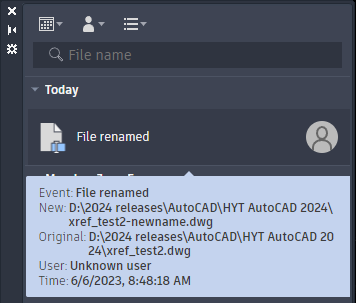
Event Filtering
Once your drawings have many logged events, you may want to filter the events on the palette to see a subset of the events for a drawing. For example, you might want to see events during a specific time range, or just your events, or specific types of events. We don't have a lot of events for these practice drawings but let's see how event filtering works.
By Event Type
- Click the Event filter drop-down menu.
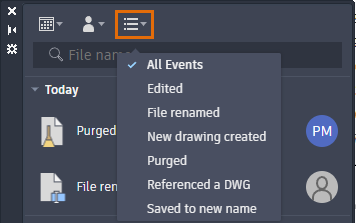
The Event filter menu contains only the events for the current drawing.
- Select each type of event that you want to view.
Each time you click a type of event, it's toggled on and off.

- To see all types of events, select All Events.
By User
- Click the User filter drop-down menu.
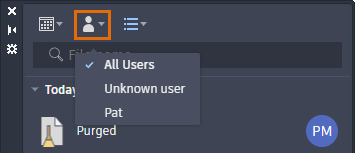
The User filter menu contains only the users that performed events to the current drawing.
- Select each user's name to view their events.
Each time you click a user's name, their events are toggled on and off.
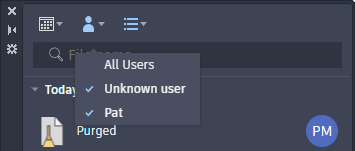
- To see events from all users, select All Users.
By Date
- Click the Date filter drop-down menu.
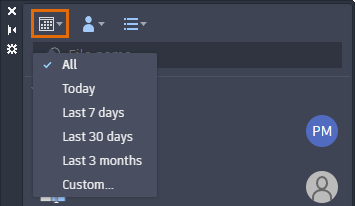
You can select from the available options or select Custom to define a range of dates.
- Select Custom.
Dates which contain events are shown in blue.
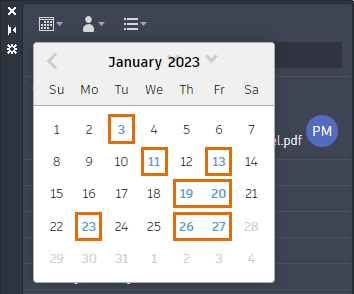
- To select a date range, first select the earliest date, then select the latest date. Click outside of the calendar to apply the date range.
- To display events regardless of date, select All from the Date filter drop-down menu.
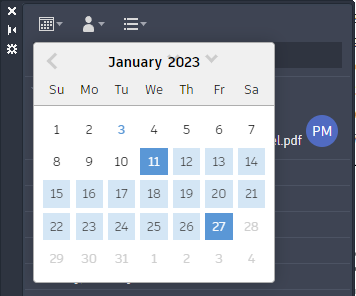
Summary
You can use Activity Insights to better manage your drawings and drawing references.